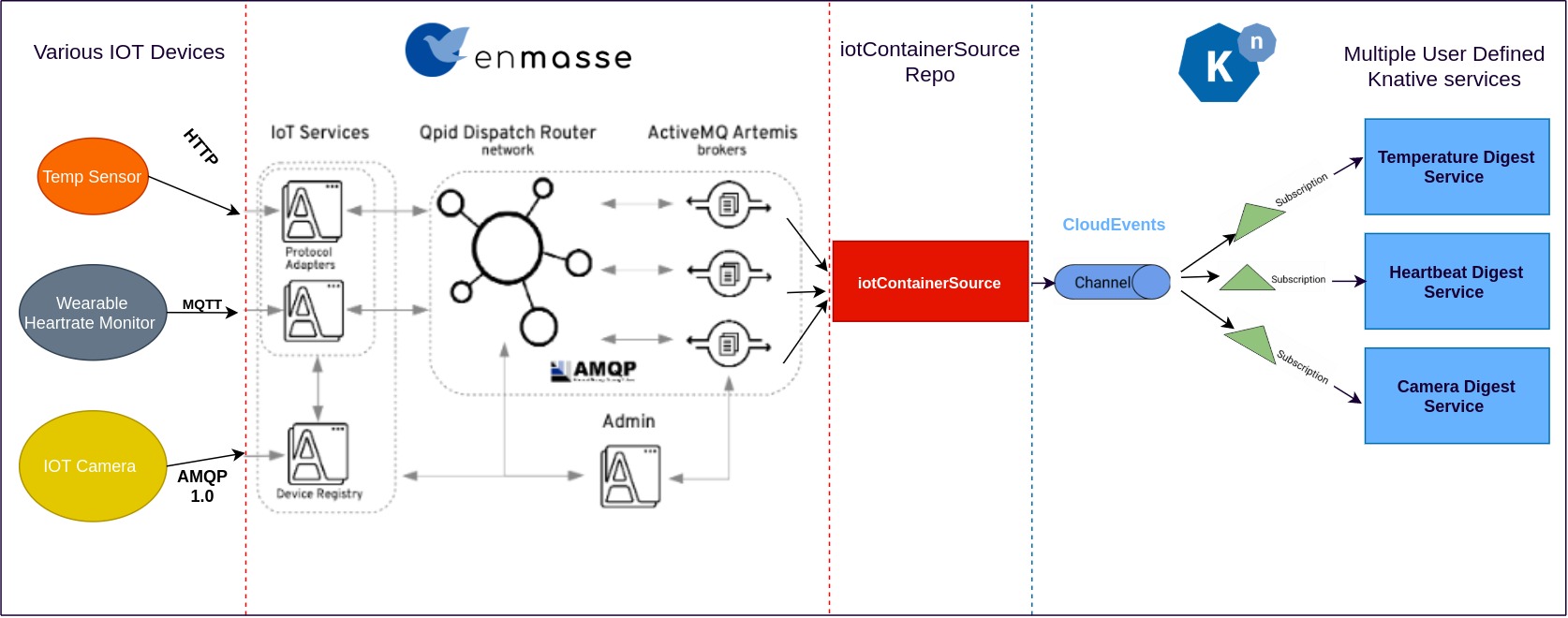The Following Repo is the implementation of a custom Knative Container Sourcehttps://knative.dev/docs/eventing/sources/ that delivers IOT data Enmasse to any Knative Service or Channel in the cloudevent format. The gernal orginazation of the stack in a real world use case could look like the following
This Project assumes the user has prior knowledge on Knative and Enmasse along with the following components already setup.
- A Running Kubernetes Cluster(Version > 1.14)
- I recommend Using CodeReadyContainers for a quick start
- For the Rest of the Docs I will be using the openshift CLI command
oc
- Enmasse Downloaded and IOT features enabled
- Knative Serving and Knative Eventing and Sources Setup on your cluster
Start by cloning the code source
git clone https://github.com/astoycos/iotContainerSource.git
Then make sure you have access to the iotContainerSource image with one of the following options
- Use the image already uploaded to my quay.io repo with tag
quay.io/astoycos/iotcontainersource - Generate your own image with provided
Dockerfileand push to personal image repository- For more info about how to build and push an image see Podman
To confirm that the iotContainerSource is working we will use a provided Knative service that simply displays incoming messages into it's log
apiVersion: serving.knative.dev/v1
kind: Service
metadata:
name: event-display
spec:
template:
spec:
containers:
- image: gcr.io/knative-releases/github.com/knative/eventing-sources/cmd/event_displayTo apply this service use
oc apply -n knative-eventing -f demo-service.yaml
Then to ensure the service is up use
oc get -n knative-eventing ksvc
This should display something like the following, which lets the user know the service is up and ready to go
NAME URL LATESTCREATED LATESTREADY READY REASON
event-display http://event-display.default.1.2.3.4.xip.io event-display-gqjbw event-display-gqjbw True
To deploy the iotContainerSource container to you cluster, a user specific instance must be created by populating the provided manifest.yaml file
apiVersion: sources.eventing.knative.dev/v1alpha1
kind: ContainerSource
metadata:
name: iotcontainersource
spec:
template:
spec:
containers:
- image: quay.io/astoycos/iotcontainersource:latest
name: heartbeats
env:
- name: POD_NAME
value: "mypod"
- name: POD_NAMESPACE
value: "event-test"
- name: MESSAGE_URI
value : ${MESSAGING_HOST}
- name: MESSAGE_PORT
value : ${MESSAGING_PORT}
- name: MESSAGE_TYPE
value: <enmasse message type>
- name: MESSAGE_TENANT
value: <enmasse message tenant>
- name: TLS_CONFIG
value: <Enmasse tls config> # 0:no tls 1: tls insecue 2: tls secure
- name: TLS_PATH
value: "${TLS_CERT}"
- name: CLIENT_USERNAME
value: <enmasse client username>
- name: CLIENT_PASSWORD
value: <enmasse client password>
sink:
apiVersion: serving.knative.dev/v1
kind: Service
name: event-displayFor initial setup purposes we will use POD_NAME="mypod" and POD_NAMESPACE="event-test" but be sure to change these if using a custom knative service
The MESSAGE_URI, MESSAGE_PORT and messaging endpoint certificate -> TLS_CERT can be collected with the following commands (If the Enmasse "Getting started using IOT" instructions were followed)
export TLS_CERT=$(oc -n myapp get addressspace iot -o jsonpath={.status.caCert} | base64 --decode)
export MESSAGING_HOST=$(oc -n myapp get addressspace iot -o jsonpath={.status.endpointStatuses[?\(@.name==\'messaging\'\)].externalHost})
export MESSAGING_PORT=443
Now the rest of the setup variables need to be addressed
MESSAGE_TYPE : telemetry/event
MESSAGE_TENANT: <IOTProject namespace>.<Enmasse Addressspace>
TLS_CONFIG: < 0:no tls 1: tls insecure 2: tls secure >
CLIENT_USERNAME: <Enmasse Messaging User Username>
CLIENT_PASSWORD: <Enmasse Messaging User Password>
Once all of the container variables are set the iotContainerSource is ready to be deployed using the command, which will populate it with preloaded environment variables
cat manifest.yaml.in | envsubst | oc apply -n knative-eventing -f -
Make sure the pod was deployed correctly with, oc get pods which should look similar to the following
[astoycos@localhost github.com]$ oc get pods
NAME READY STATUS RESTARTS AGE
containersource-iotcontain-07d8c895-4ed6-430c-bcee-1572bcan7wdk 1/1 Running 0 25s
eventing-controller-6f4bbb779b-8zznh 1/1 Running 0 7d3h
eventing-webhook-9c697c59-4kj7q 1/1 Running 0 7d3h
imc-controller-675dd47677-7bpz8 1/1 Running 0 7d3h
imc-dispatcher-6c9875f557-tr4s6 1/1 Running 0 7d3h
sources-controller-6bf9f6d958-28gpt 1/1 Running 0 7d3h
Now we are finally ready to test our iotContainerSource, go to a local terminal and run
curl --insecure -X POST -i -u sensor1@myapp.iot:hono-secret -H 'Content-Type: application/json' --data-binary '{"temp": 5}' https://$(oc -n enmasse-infra get routes iot-http-adapter --template='{{ .spec.host }}')/telemetry
to simulate an iot device pushing data to the enmasse http adapter.
now run oc logs containersource-iotcontain-07d8c895-4ed6-430c-bcee-1572bcan7wdk The output should resemble the following
[astoycos@localhost github.com]$ oc logs containersource-iotcontain-07d8c895-4ed6-430c-bcee-1572bcan7wdk
2020/02/13 18:14:11 Sink set by Yaml
2020/02/13 18:14:11 Consuming telemetry data from enmasse endpoint: messaging-8lxzny44dx-enmasse-infra.apps.astoycos-ocp.shiftstack.com
2020/02/13 18:14:11 Consumer running, press Ctrl+C to stop...
2020/02/13 18:15:48 Device Data received
2020/02/13 18:15:48 Making cloudevent
2020/02/13 18:15:48 Sending cloudevent to http://event-display.knative-eventing.svc.cluster.local
2020/02/13 18:15:58 Consuming telemetry data from enmasse endpoint: messaging-8lxzny44dx-enmasse-infra.apps.astoycos-ocp.shiftstack.com
2020/02/13 18:15:58 Consumer running, press Ctrl+C to stop...
This Shows that our iot data was received by the iotContainerSource and that it sent a new CloudEvent to our temporary Knative Service which simply dumps the cloudevent into its log
If you quickly type oc logs -l serving.knative.dev/service=event-display -c user-container --since=10m you will see the cloud event received by the service
[astoycos@localhost github.com]$ kubectl logs -l serving.knative.dev/service=event-display -c user-container --since=10m
datacontenttype: application/json
Extensions,
deviceid: 4711
messagetype: application/json
resource: telemetry/myapp.iot/4711
tenantid: myapp.iot
Data,
{
"temp": 5
}
If you are having trouble setting up anything along the way feel free to raise an issue and I will do my best to address it :)
- Much of the Enmasse consumer Code was borrowed from @ctron's repo I could not have completed this project without his help
- etc
